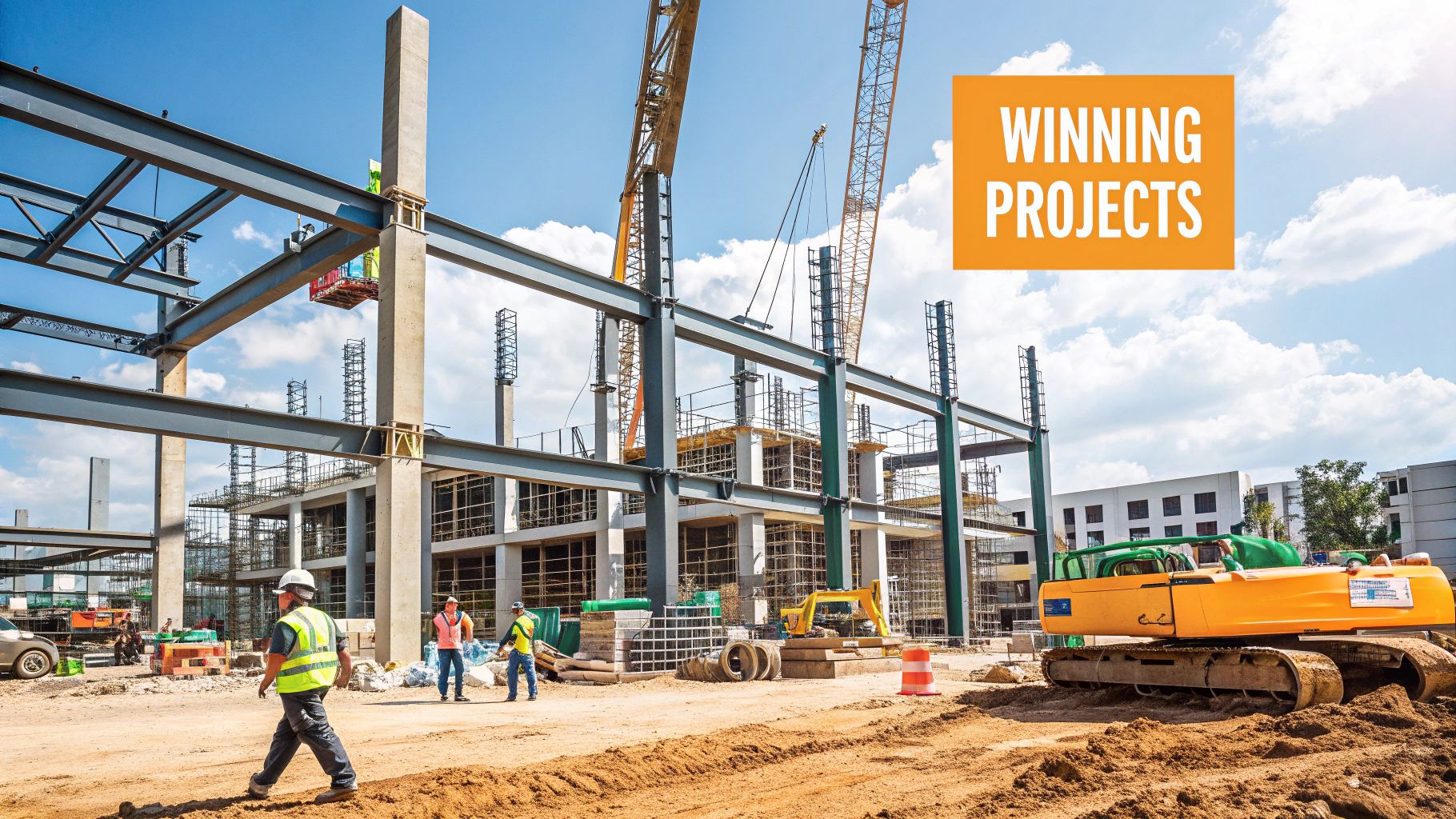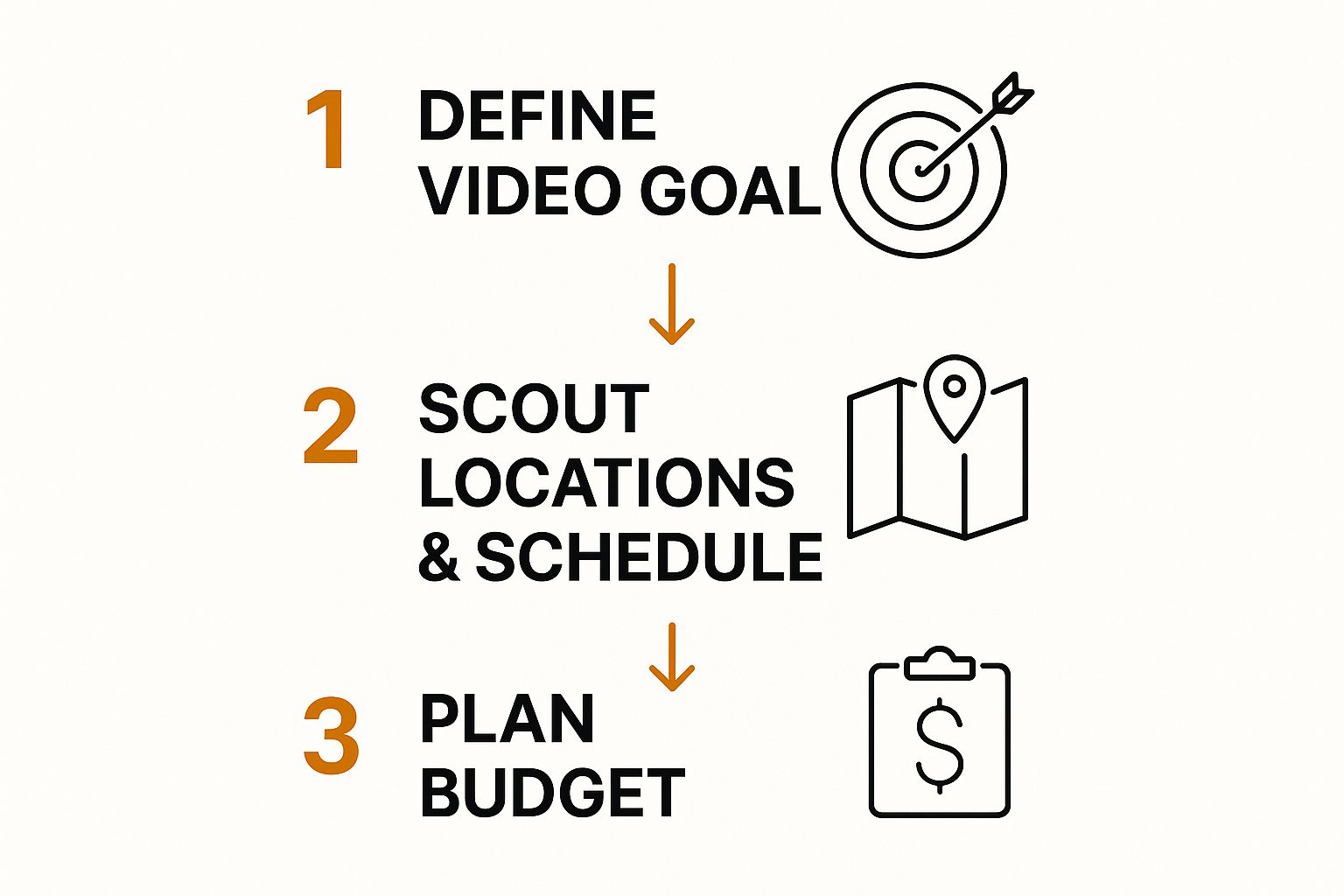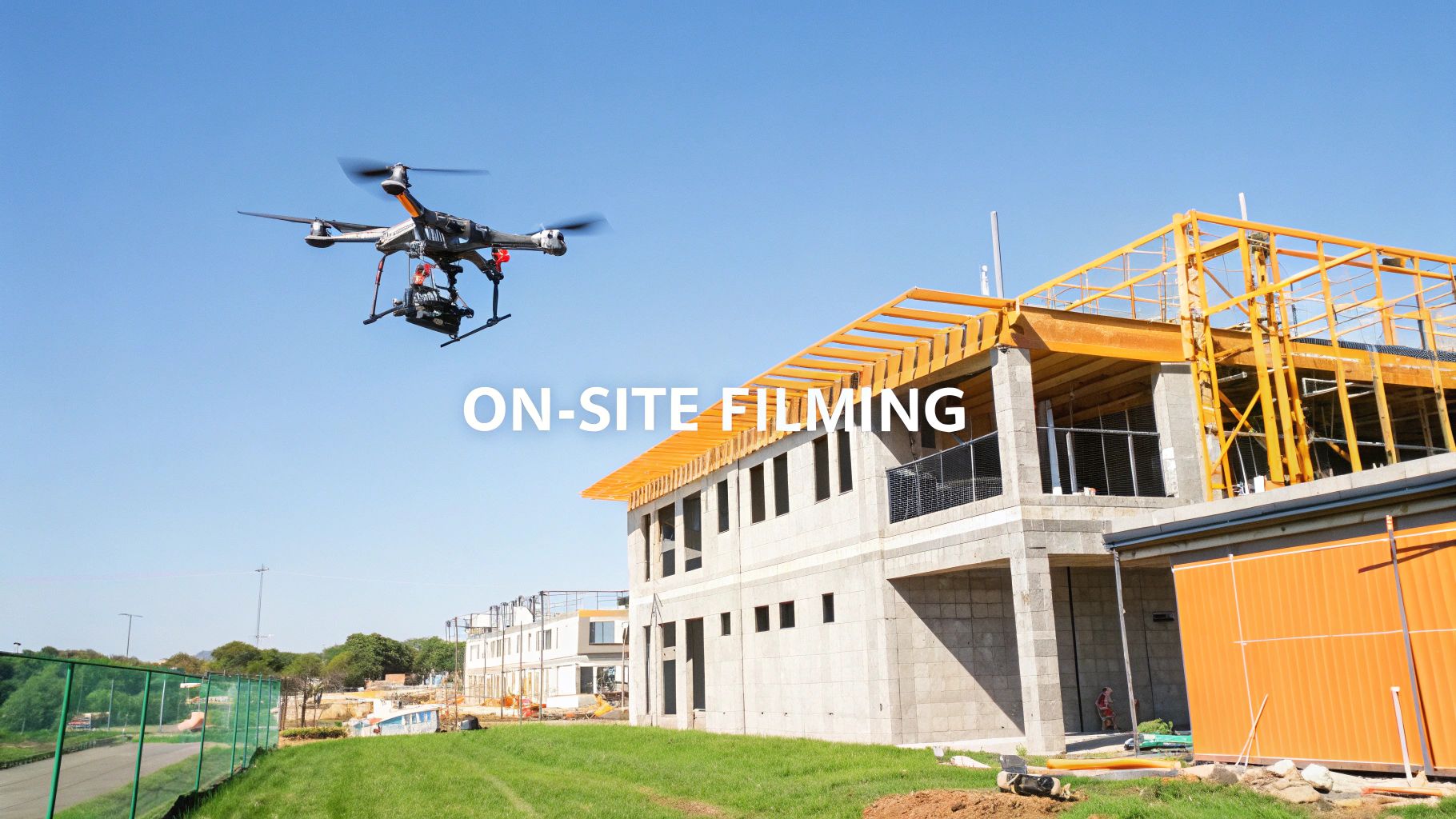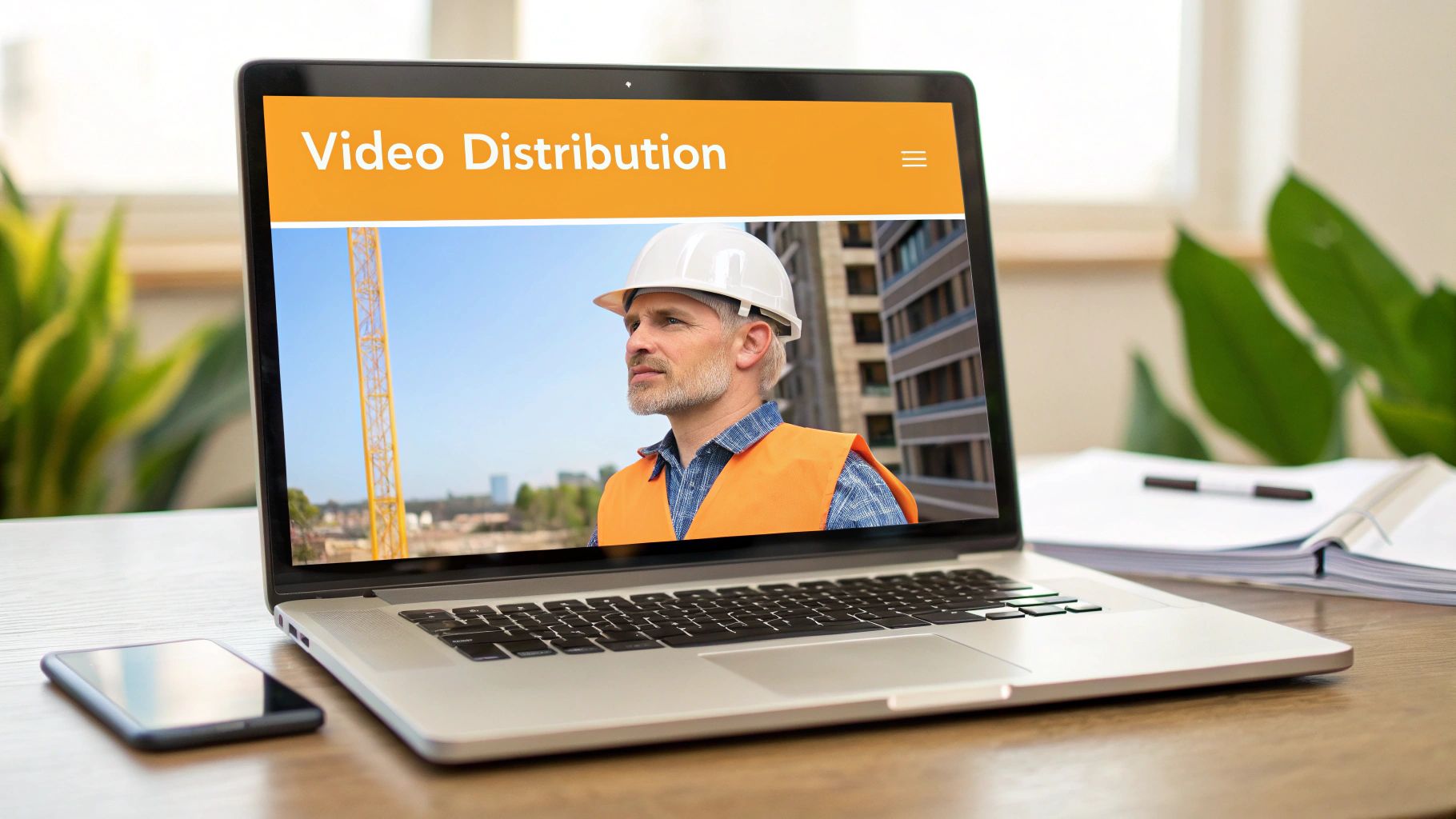


In the construction game, trust is everything. Before a client picks up the phone, they want proof of your work. Today, professional video is the best way to deliver it. A high-quality video production video isn’t a nice-to-have; it's a core tool that builds credibility, showcases your craftsmanship, and brings in better leads.

Still photos are good, but they don’t capture the scale and feel of a finished project. A well-produced video brings your work to life. It shows potential clients the flow of a space, the fine details, and the professionalism of your team on site.
Think of it like this: your video is your best salesperson, working 24/7 on your website and social media. It answers questions before they’re asked and builds confidence. The right clients see exactly what you’re capable of, filtering out those who aren’t a good fit.
Trust is the foundation of any build. Clients are making a huge investment. They need to know they’re hiring a crew that is skilled, reliable, and proud of their work.
Video is the most powerful tool for building that trust remotely. It lets you:
This isn't about making a slick corporate ad. It's about honestly documenting your craft. It shows you have nothing to hide and are confident in the quality you deliver. This is why having a skilled builder videographer is a game-changer for winning high-value projects.
The way people research and choose builders has changed. Potential clients expect to see video content that gives them the full picture, on their own time.
The New Zealand media market backs this up. Video advertising spend in New Zealand is forecast to hit US$505.76 million in 2025. Businesses are investing in video because that’s where their customers are. For builders, this means a professional video is a competitive necessity. You can dive deeper into the NZ video market on Statista.
Your video becomes a permanent asset. It’s a tool that proves your value, separates you from the competition, and helps you secure better projects with clients who already trust you.
Investing in a professional video production video makes your business more efficient. It cuts down on site visits with unqualified leads. When your phone rings, it’s a potential client who’s already impressed and ready to talk business.
The best videos are made long before the camera starts rolling. A successful shoot is all about the groundwork—the planning that happens behind the scenes. This pre-production phase turns a good idea into a practical plan that delivers results.
Skipping pre-production is like starting a build without blueprints. You’ll burn time and money, and end up with something that doesn’t meet the brief.
First, what is the job of this video? A video without a clear goal is just a collection of nice shots. You have to decide its primary function. This shapes everything that follows, from the script to the filming locations.
Your goal could be:
Once you nail the why, you can map out the how. This clarity ensures your final video production video doesn't just look good—it actively works to grow your business.

This simple workflow shows how a clear goal forms the foundation, followed by practical logistics like sorting locations and scheduling, with budgeting as the final checkpoint.
A checklist is your best friend for making sure nothing gets missed. This table breaks down the essentials, helping you tick off the big items before filming day.
Running through this checklist aligns everyone and sets the stage for a filming day that’s efficient and on-point, not chaotic.
With your goal locked in, it's time to outline what the video will show and say. This doesn't need to be a Hollywood screenplay. For most construction videos, a simple shot list or a structured outline is more effective.
Authenticity is key. The language needs to sound like it’s from a builder, not a marketing department. Think about the key messages you want to get across and the best visuals to back them up. If you’re highlighting precision, your shot list might include close-ups of detailed joinery.
A well-thought-out plan is your best defence against a chaotic, expensive filming day. It aligns your crew, the video team, and any clients, ensuring the day runs smoothly.
This is also the time to decide who will be on camera. Will you feature your team? A satisfied client? Answering these questions now prevents delays on the day.
For builders, the "set" is often an active construction site. This demands careful planning to capture great footage without disrupting workflow or compromising safety.
First, scout your locations in advance. Walk the site with your video producer. Together, you can find the best spots for interviews, check the natural light, and identify areas that showcase your work. A half-finished renovation in Tauranga might have a stunning new kitchen perfect for detail shots, but a noisy drop saw nearby needs to be silenced during interviews.
Next, schedule wisely. Coordinate with your site foreman to plan filming around major construction activities. Capturing a concrete pour gives you impressive action shots, but it's not the best time for a quiet interview.
Good communication between your team and the film crew is essential. To see how we manage these logistics, you can read more about how Onsite Media works throughout New Zealand.
Finally, let’s talk money. A clear budget prevents surprises and ensures you get the best value. Your costs will be influenced by a few key factors:
Be upfront with your video production partner about your budget. A good partner will work with you to create a plan that fits your budget while hitting your key objectives. A smart investment in planning ensures every dollar spent on filming day is put to the best use.

This is the day all that planning comes to life. When the film crew arrives on site, it should be a controlled, collaborative effort, not a chaotic interruption.
A professional video shoot is built on efficiency and safety. It’s also built on understanding what makes a construction site visually compelling. The goal is to tell the story of your craftsmanship, your team’s professionalism, and the scale of what you build.
A bit of site prep goes a long way. This isn't about making your site look fake. It's about presenting your work in its best light and getting rid of distracting clutter.
A clean, organised site speaks volumes about your professionalism. Coil up stray leads, tidy loose materials, and clear mess from key filming areas. A tidy site looks safer and more professional, letting the quality of your work be the hero of the shot.
To build a powerful story, you need a mix of footage that shows both the big picture and the small details. This variety makes the final video engaging.
Wide shots, especially from a drone, are gold for showing the scale of a project. They can frame a new build in Tauranga against the coast or show how an extension integrates with the original home. These shots establish context.
Close-ups are where you prove your quality. These shots are about the details—the clean lines of cladding, the precision of a mitre joint, or the flawless finish on custom cabinetry. This is the visual proof that backs up your claims of being a quality builder.
Action shots of your team at work bring energy and authenticity. Filming a chippy setting a beam or a plasterer skimming a wall shows expertise in motion. This combination of wide, detail, and action shots paints a complete picture of what you do.
Putting your crew on camera is a great way to humanise your brand. It’s normal for people to be nervous with a lens pointed at them. The trick is to keep things relaxed and natural.
Forget stiff, scripted lines. Instead, the director can ask simple, open-ended questions about their work. "What's the trickiest part of this stage?" or "What are you most proud of on this build?" This approach gets genuine, unscripted answers.
Another tactic is to film them while they're working. When someone is focused on their craft, they often forget the camera is there. These shots capture pure concentration and skill. Remind your team they're the experts—they just need to talk about what they do every day.
A construction site is a noisy place. Between saws, generators, and the radio, capturing clean audio is a challenge. But bad audio will kill an otherwise great video.
If viewers can't hear what's being said, they'll switch off. Your message will be lost. This is why a pro crew uses gear like lapel mics and boom poles to isolate a person's voice from background noise.
Here’s why it’s so critical:
A simple strategy is to schedule interviews during quieter times, like smoko or the end of the day. Pausing noisy work for five minutes to get a key soundbite is a small price to pay for a polished video.
Filming is done. We have hours of raw footage from your site. Now the real work begins. This is where we transform those individual shots into a polished, powerful story that gets you results.
This is the post-production phase, where the narrative takes shape. It’s a process of sifting, selecting, and arranging, then adding the layers of polish that make the difference between a good video and a professional marketing tool.
First, we dive into all the footage. Our editors hunt for the golden moments: the perfect shot of a finished detail, a genuine comment from a team member, or that stunning drone shot that captures the scale of your project.
These clips are then laid out on a timeline to create the first ‘rough cut’. This version is all about the story and rhythm. Does it flow logically? Does it hit the key messages we agreed on in the planning stage? It's about building a solid foundation for your story.
Once the story is locked in, we work on the colour grade. This is a massive step. It’s what ensures your video looks professional and premium, not like something shot on a phone.
Colour grading is more than just brightening an image. It’s about adjusting tones and hues to create a consistent, high-end look. For a construction company, that means:
A professional colour grade separates amateur footage from a high-end video production. It guarantees the visual quality of your video matches the real-world quality of your builds, reinforcing your reputation.
This process also ensures a shot filmed in bright morning sun matches one captured on a cloudy afternoon, creating a smooth viewing experience.
Visuals get the attention, but sound keeps it. If your interviews are muffled or the music is distracting, the video loses its impact. Sound design is about balancing every audio element to create a clean, professional mix.
This usually involves:
The goal is a video that sounds as good as it looks. This attention to audio is a hallmark of the wider New Zealand screen industry, which generates NZ$3.5 billion annually. The same professional standards apply to your video. You can learn more about the benefits of New Zealand's screen industry and its impact.
The final touches are about adding simple, effective graphics to reinforce your brand and give viewers a clear next step. This is about practical, professional additions that make your video a better business tool.
This typically includes:
These elements are designed to be clean and unobtrusive, adding a layer of professionalism without distracting from the real star of the show: your work.
Post-production is a team effort. Once we have a polished draft, we’ll send it to you for feedback. This is your chance to review the edit and make sure it aligns with your vision.
We make this process easy. You can leave time-stamped comments directly on the video. Constructive feedback is what we're after—the more specific you are, the quicker we can nail the final version.
This back-and-forth ensures the final video isn't just something we've created for you, but something we've built with you. The result is a powerful marketing asset you can be proud of—one that helps you win more of the right projects.

Creating a great video is a huge achievement, but it's only half the battle. A video sitting on a hard drive doesn’t generate leads. Now it's time to get that asset in front of the right people.
This is a straightforward plan to make sure your investment pays off by getting your new video seen by potential clients and partners.
First, get the video on your website. It’s your digital storefront, and a well-placed video can make a massive first impression on someone looking to hire a quality builder.
Think about the prime real estate on your site:
Placing your video strategically on your website helps visitors connect with your brand, keeping them on the page longer and making them more likely to get in touch.
Social media is where you can push your video out to a wider audience. But you can't just post the same file everywhere. Each platform has its own rules.
To ensure your videos load quickly and look sharp, you need to optimize videos for social media with effective compression.
For a construction business, Instagram and Facebook are usually your best bets. On Instagram, a short, punchy version under 60 seconds is perfect for Reels. For Facebook, you can go a bit longer—up to two minutes—to tell a more detailed story. Making sure your social video production is formatted correctly for each platform gets results.
Pro Tip: Don’t forget to add captions. A huge number of people watch videos with the sound off, especially on their phones. Without captions, your message is lost.
Your new video is a versatile asset. It can and should be used in other parts of your business. These are practical ways to make that video work harder for you.
Here are a few high-impact places to use it:
By using your video across all these touchpoints, you create a consistent, professional brand image that builds credibility and helps you win more work.
We get it. Investing in professional video is a big decision. Here are some straight answers to the questions we hear most often from builders.
The honest answer is: it depends. A video’s price is tied directly to the time and resources needed.
Think of it like one of your own builds—a simple bathroom reno has a different budget than a complex architectural home.
A few key things influence the final price:
We always provide a clear, itemised quote from the start. The goal is to match the project to your budget and business goals, making sure every dollar works hard to win you more jobs.
From our first chat to the final files, a typical video project takes four to six weeks. This gives us enough time for proper planning, which is the most critical part of getting it right.
Here’s a rough breakdown:
To dig deeper into the entire creative journey, this guide is a great resource to master the video production workflow.
Your main role is to bring your expertise and give us access. We handle the technical and creative work, but we count on you for the core of the story.
During planning, we’ll need your input on the video's goals and key messages. On filming day, we need a point of contact on site and for your team to be ready. We work hard to keep disruption to a minimum so your crew can stay focused on the job.
The best videos are a true collaboration. You bring the building expertise and authentic stories; we bring the filmmaking craft to capture it professionally. It’s a partnership designed to show off your quality.
Essentially, you focus on what you do best, and we’ll focus on ours. The result is a powerful video that looks and feels like your brand, ready to build trust and attract your ideal clients.
Ready to put your craftsmanship in the spotlight? Onsite Media builds powerful video content that helps New Zealand’s best builders win better projects. Start the conversation with us today.

